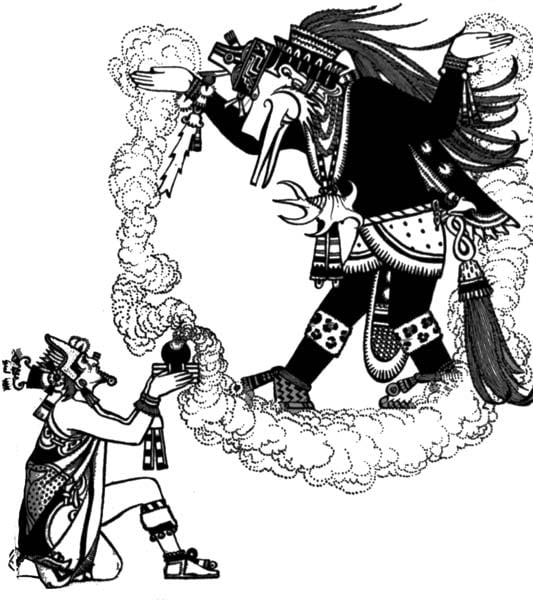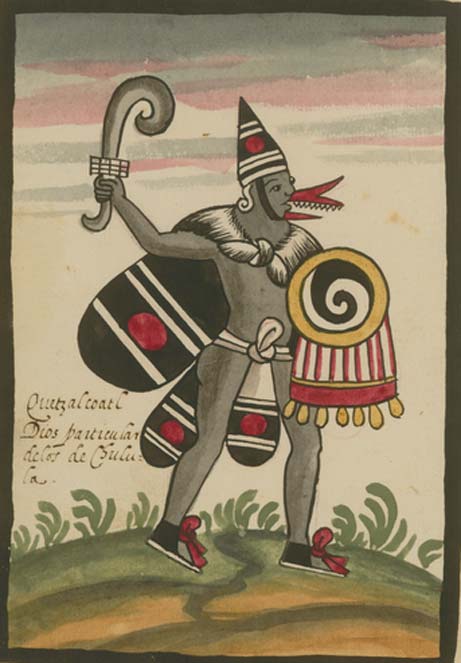
Quetzalcoatl: From Feathered Serpent to Creator God
Quetzalcoatl, a feathered serpent or ‘plumed serpent’, was one of the most important gods in the ancient Mesoamerican pantheon. The name Quetzalcoatl is a combination of two Nahuatl (the language of the Aztecs) words, quetzal, which is the emerald plume bird, and coatl, which means serpent. Therefore, Quetzalcoatl is commonly also known in English as the Plumed Serpent or Feathered Serpent.
Finding the Origins of Quetzalcoatl
But this deity was known by other names in other Mesoamerican civilizations. The Maya people, for instance, referred to Quetzalcoatl as Kukulkán, whilst the Quiché of Guatemala knew this god as Gucumatz.

The Aztec god Quetzalcoatl as depicted in the Codex Telleriano-Remensis (16th century). (Public Domain)
The roots of Quetzalcoatl, or at least the form of the feathered serpent, can be traced all the way back to the Olmec civilization, which existed from around 13th to the 5th centuries BC. The representation of a divine feathered serpent can be found on a famous Olmec stone-carving known as La Venta Monument 19, in which a man in shown to be seated before this creature. The cult of Quetzalcoatl, however, only emerged several centuries later, during the Late Classical period.
- River of Mercury in Underworld of Pyramid of Quetzalcoatl may lead to Royal Tomb
- Bearded Gods of the Americas Were Jesus Resurrected?! Maybe. But Why is the Plumed Serpent Ubiquitous?
- Aztec Creation myths

A photo of La Venta Stela 19, the earliest known representation of the Feathered Serpent in Mesoamerica. (Audrey and George Delange)
New Features for Quetzalcoatl
One of the civilizations of this period in which Quetzalcoatl was worshiped was the Teotihuacan civilization, which existed between the 3rd and 8th centuries AD. It seems that the people of this civilization worshipped Quetzalcoatl as a vegetation god, a deity of the earth and water that was closely connected to Tlaloc, a rain god.
Certain substantial changes occurred to the cult of Quetzalcoatl when the Toltecs came to power. During this period, Quetzalcoatl was transformed into the god of the morning and evening star - as war and human sacrifice, which were central features of this culture, were linked with the worship of heavenly bodies. In this role as the two stars, Quetzalcoatl was also a symbol of death and rebirth.

Quetzalcoatl in feathered serpent form as depicted in the Codex Telleriano-Remensis. (Public Domain)
Quetzalcoatl’s role as a solar deity was maintained during the Aztec period, though he was given a number of other roles as well. For example, Quetzalcoatl was associated with the planet Venus, became the protector of the goldsmiths and other craftsmen, and was considered to be the god of learning, science, crafts, arts, and agriculture.
Quetzalcoatl is also said to have invented the calendar and discovered maize, two important features of the Aztec civilization. Moreover, Quetzalcoatl became strongly associated with the winds, specifically as a bringer of rain clouds, which was important to a society dependent on agriculture.

Montezuma offering incense to Quetzalcoatl. (Public Domain)
Quetzalcoatl in Creation Myths
Most importantly, however, is the elevation of Quetzalcoatl to the status of a creator god. According to the Aztecs, Quetzalcoatl was one of the four sons of Tonacateuctli and Tonacacihuatl, the original creator gods. Quetzalcoatl and one of his brothers, Tezcatlipoca, were given the task of creating the world.
In one version of the myth, the two brothers constantly fight with each other, which resulted in the creation and destruction of several successive ages. During the 1st Age, for instance, Quetzalcoatl attacked Tezcatlipoca with a stone club, causing his enraged brother to command his jaguars to eat up all the people. The Aztecs believed that this cycle of creation and destruction happened four times, and that we are currently living in the 5th Age.
- Tezcatlipoca: How Does the Supreme God of the Aztecs Compare to Other Omnipotent Deities?
- Residents upset with greedy elites burned Teotihuacan
- Aztec Death Whistles Sound like Human Screams and May Have Been Used as Psychological Warfare

Quetzalcoatl as depicted in the post-Conquest Tovar Codex. (Public Domain)
In an alternate version of the myth, the two brothers are more co-operative and succeeded in creating the earth and the sky by transforming themselves into giant serpents and ripping a female reptilian monster known as Tlaltcuhtli (or Cipactli) in half. The two gods then created other things, such as the sun and the moon, the first man and woman, and other gods.
To create humans, Quetzalcoatl had to go into the Underworld and collect some bones. He took his companion Xolotl, a dog-headed god, with him. Mictlanteuctli and Mictlancihuatl, the two gods that ruled that realm, gave him a puzzle he was expected to complete before he could take the bones. He was expected to blow a conch shell horn without holes in it. Quetzalcoatl got worms to make holes in the shell then put bees inside it so the shell would make a sound.
Although he completed the task, Quetzalcoatl decided he was going to steal some of the bones and then pretend he was leaving the Underworld with none. He was caught by one of the Underworld gods and falls into a pit that was made to trap him, where he dropped and mixed the male and female bones. But Quetzalcoatl was able to escape the pit and took the bones to the snake goddess Cihuacoatl, who formed them into human beings by mixing the bones, corn, and some of Quetzalcoatl’s blood.
Quetzalcoatl’s End
There is a Toltec myth describing how Quetzalcoatl came to an end. In that myth, the god was a priest-king of Tula, and never offered human sacrifices, only plants or small animals. Alternatively, the god only accepted such sacrifices, and not human blood.
In any case, Tezcatlipoca was unhappy with Quetzalcoatl, and wanted to get rid of him. Tezcatlipoca succeeded in getting Quetzalcoatl drunk, which caused him to commit incest with his sister, Quetzalpétatl. When he awoke, Quetzalcoatl was ashamed of himself, and wandered all the way down to the Atlantic coast. In one version of the myth, he built a pyre, and immolated himself on it, later emerging as the planet Venus. In another, he sailed away into the east on a raft made of snakes.
Some scholars suggest that this story of Tezcatlipoca’s victory over Quetzalcoatl is a reflection of real events. In this interpretation, Quetzalcoatl’s defeat is a representation of the Teotihuacan culture’s social and religious revolution when the military overthrew the priests for power.

Statue of Quetzalcoatl as a feathered serpent. (CC BY SA 2.0)
Top image: A depiction of Quetzalcoatl as a feathered serpent in Teotihuacan Source: CC BY SA 3.0
By: Wu Mingren
References
Crystalinks.com, 2017. Quetzalcoatl. [Online]
Available at: http://www.crystalinks.com/quetzalcoatl.html
Minster, C., 2017. Nine Facts About Quetzalcoatl. [Online]
Available at: https://www.thoughtco.com/facts-about-quetzalcoatl-2136322
Myths Encyclopedia, 2017. Quetzalcoatl. [Online]
Available at: http://www.mythencyclopedia.com/Pr-Sa/Quetzalcoatl.html
The Editors of Encyclopædia Britannica, 1998. Quetzalcóatl. [Online]
Available at: https://www.britannica.com/topic/Quetzalcoatl
Weaver, S., 2014. Quetzalcoatl is Deeper Than Just a Mayan Story or Myth. [Online]
Available at: http://www.2012-spiritual-growth-prophecies.com/quetzalcoatl.html















